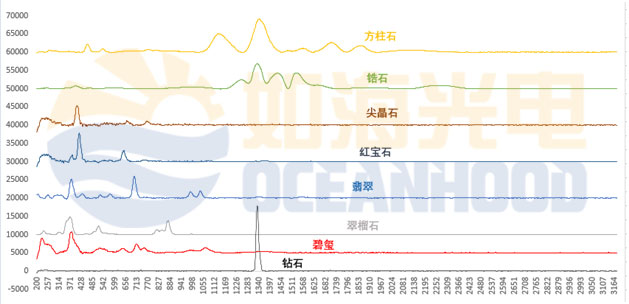| Launch:2019-07-26 |
* Introduction
With the progress of science and technology, jewelry synthesis technology has become increasingly mature, for those engaged in jewelry trading and testing, invisibly increased the difficulty of testing and identifying the true and false jewelry, grade, grade. Since the discovery of jewelry, people have been studying the detection methods of jewelry, from the beginning of the development of naked eye recognition to today with other development to today with more analytical instruments to identify, jewelry detection means can be said to have undergone earth-shaking changes.
In the past, gem microscopy and refractometer were mainly used in the identification of jewellery. These tools mainly based on the optical properties of minerals to make qualitative recognition and identification of jewellery. But because some kinds of gemstones have very similar luminosity, it is impossible to distinguish true and false jewelry accurately by common methods. In addition, the rapid development of jewelry synthesis and optimization technology makes it more and more difficult to distinguish synthetic jewelry from natural jewelry.
In the jewelry detection process, the commonly used technical means mainly include: ultraviolet-visible absorption spectrum, Raman spectrum, infrared spectrum technology, electron probe technology, X-ray diffraction technology and scanning electron microscopy analysis technology, Raman spectrum detection technology because of its fast, non-destructive, accurate, won the unanimous recognition of the industry.
Raman spectroscopy is a kind of scattering spectroscopy which occurs in the vibration of material molecules. Through the analysis of Raman spectroscopy of jewelry, we can know the rotational energy level of molecular vibration in jewelry, thus we can identify and analyze the types, grades and authenticity of jewelry.
* Application
1. preparation for experiment
100 standard jewelry, diamond and gem samples, 6 jewelry prediction samples, EVA3000Plus hand-held Raman spectrometer and probe accessories, notebook computer.
2. experimental instruments
EVA3000Plus, Raman solid inspection attachment.
Handheld Raman spectrometer EVA3000Plus produced by Shanghai Oceanhood Optical Technology Co., Ltd.
Instrument parameters:
Special range | 200cm-1~3200cm-1 |
Wavelength resolution | 4~13cm-1@1000cm-1 |
Excitation wavelength | 785±0.5nm |
Output power | 0~500mW |
Integration time | 1ms~10s |
Probe working distanc | 7.5mm |
3. experimental method
Step1, take out 100 gemstone standard samples, row out, count the quantity. Prepare a set of empty boxes and place the samples after testing.
Step 2. Put a solid attachment cap on the EVA3000Plus hand-held Raman spectrometer to measure the gemstone samples. Before measuring, please record the name and number of the gemstones. After measuring, keep the spectrogram on the equipment. The name should be the same as the number of the gemstones.
Step 3, 100 standard samples were tested in turn, and a standard gemstone sample library was established.
Step 4, take out 6 jewellery samples to be tested, measure them in sequence, match with the database, check the database.
Step 5, all jewellery is placed in accordance with classification and reduction, and the experiment is finished.
Caution: samples with relatively small diamonds mainly prevent samples from falling and missing.
* Result discussion
The Raman spectra of 100 standard jewelry samples and 6 samples to be predicted are obtained. The following figure shows the Raman spectral similarity (spectral smoothing, baseline subtraction, normalized data processing) between the sample to be measured and the standard sample library:

Conclusion 1:
From the above diagram, the similarity between the predicted sample 1 and the quartzite standard sample is 91.5%, and the similarity between the tested sample 2 and the olivine standard sample is 85.6%. Therefore, it can be judged that the tested sample 1 belongs to quartzite and the tested sample 2 belongs to olivine
The Raman spectra of 8 large categories of jewelry from 100 standard samples are compared.

Conclusion two:
From the above picture, different types of jewelry Raman spectrogram peak position difference is obvious, using EVA3000Plus hand-held Raman spectrometer to identify different types of jewelry is feasible.

